|
|

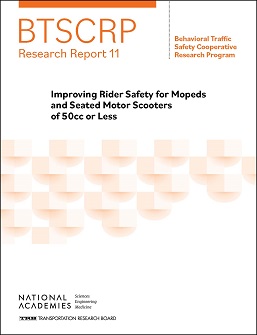 Improving Rider Safety for Mopeds and Seated Motor Scooters of 50cc or Less
5/30/2024 5:00:55 PM
Improving Rider Safety for Mopeds and Seated Motor Scooters of 50cc or Less
5/30/2024 5:00:55 PM
Relative to passenger cars, two- and three-wheeled vehicles such as motorcycles, mopeds, and seated motor scooters (50cc or less) are associated with a higher risk for fatalities and serious injuries in the event of a traffic crash, as they do not offer the protection of an enclosed vehicle or include other safety enhancement features such as occupant restraints. BTSCRP Research Report 11: Improving Rider Safety for Mopeds and Seated Motor Scooters of 50cc or Less , from TRB's Behavioral Traffic Safety C...
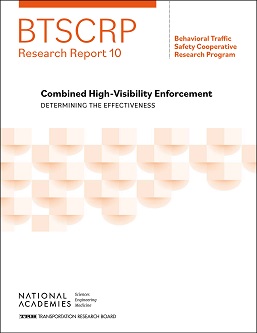 Combined High-Visibility Enforcement: Determining the Effectiveness
4/4/2024 7:00:51 PM
Combined High-Visibility Enforcement: Determining the Effectiveness
4/4/2024 7:00:51 PM
The National Highway Traffic Safety Administration defines high-visibility enforcement (HVE) as a universal traffic safety approach designed to create deterrence and change unlawful traffic behaviors. HVE combines highly visible and proactive law enforcement targeting a specific traffic safety issue. Law enforcement efforts are combined with visibility elements and a publicity strategy to educate the public and promote voluntary compliance with the law. BTSCRP Research Report 10: Combined High-Visibility...
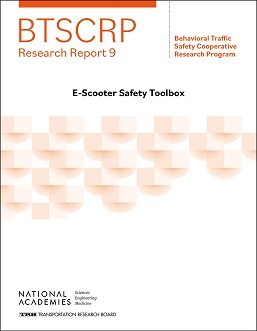 E-Scooter Safety Toolbox
9/14/2023 4:00:09 PM
E-Scooter Safety Toolbox
9/14/2023 4:00:09 PM
Since their introduction in the United States in 2017, the use of electric scooters (e-scooters) has expanded to the streets and sidewalks of many cities, and all indicators point to continued growth. BTSCRP Research Report 9: E-Scooter Safety Toolbox , from TRB's Behavioral Traffic Safety Cooperative Research Program, presents findings from a multiyear research effort that sought to build on existing research to date, identify key gaps in knowledge and data related to e-scooter behavioral safety, and de...
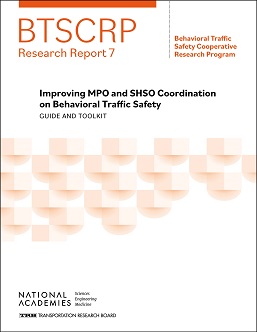 Improving MPO and SHSO Coordination on Behavioral Traffic Safety: Guide and Toolkit
8/24/2023 2:00:36 PM
Improving MPO and SHSO Coordination on Behavioral Traffic Safety: Guide and Toolkit
8/24/2023 2:00:36 PM
State highway safety offices (SHSOs) manage behavioral traffic safety programs at the state level. At the regional level, metropolitan planning organizations (MPOs) develop safety performance measures and targets. BTSCRP Research Report 7: Improving MPO and SHSO Coordination on Behavioral Traffic Safety: Guide and Toolkit , from TRB's Behavioral Traffic Safety Cooperative Research Program, presents evidence-based information and tools to help improve coordination between SHSOs and MPOs on behavioral traf...
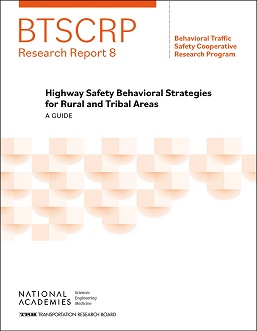 Highway Safety Behavioral Strategies for Rural and Tribal Areas: A Guide
8/3/2023 6:00:16 PM
Highway Safety Behavioral Strategies for Rural and Tribal Areas: A Guide
8/3/2023 6:00:16 PM
Roadway fatalities and serious injuries are a significant public health concern in rural and tribal settings. Creating a coalition of interested individuals is part of the Safe System Approach that addresses the high rates of these fatalities and serious injuries. BTSCRP Research Report 8: Highway Safety Behavioral Strategies for Rural and Tribal Areas: A Guide , from TRB's Behavioral Transportation Safety Cooperative Research Program, details this approach, which includes strategies for safer people, sa...
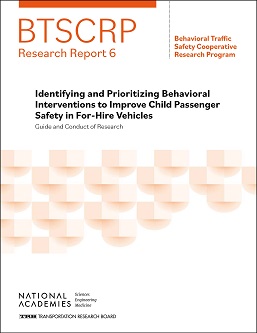 Identifying and Prioritizing Behavioral Interventions to Improve Child Passenger Safety in For-Hire Vehicles
6/2/2023 2:00:32 PM
Identifying and Prioritizing Behavioral Interventions to Improve Child Passenger Safety in For-Hire Vehicles
6/2/2023 2:00:32 PM
Child restraint systems (CRS) requirements for children in rideshare vehicles vary by state and city. In 43 states, child passengers in rideshare vehicles are required to be secured in appropriate CRS. However, 28 states exempt taxis from the CRS requirement. Of the 12 cities with relevant policies, eight (67%) require CRS in rideshare vehicles, but not taxis; two cities (17%) require CRS use in both rideshare vehicles and taxis. BTSCRP Research Report 6: Identifying and Prioritizing Behavioral Intervent...
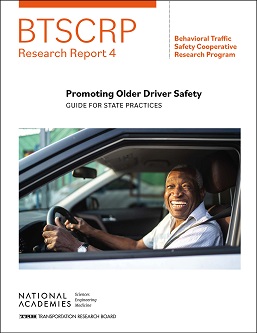 Promoting Older Driver Safety: Guide for State Practices
3/23/2023 2:00:05 PM
Promoting Older Driver Safety: Guide for State Practices
3/23/2023 2:00:05 PM
The large number of baby boomers, who are likely to drive much longer than previous generations, points to an increased need for older-driver safety programs and policies. As state-level agencies charged with providing information and programs on behavioral traffic safety, state highway safety offices (SHSOs) are a logical place for either developing and managing a more extensive older-driver safety program or providing funding and leadership for other agencies that conduct these programs. The TRB Behavi...
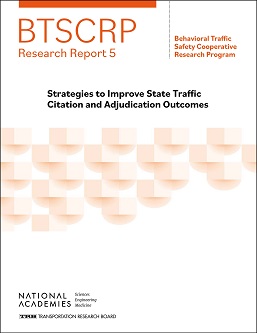 Strategies to Improve State Traffic Citation and Adjudication Outcomes
1/25/2023 3:00:56 PM
Strategies to Improve State Traffic Citation and Adjudication Outcomes
1/25/2023 3:00:56 PM
The ability of state agencies to track citation, adjudication, and disposition data accurately and effectively is essential for the identification and appropriate adjudication of problem drivers and habitual offenders. Efficient data tracking can provide benefits at all steps of the citation-adjudication process, from providing real-time information and safer roadside stops for law enforcement officers to reducing errors and improving transmission speed during the adjudication stage to facilitating data ...
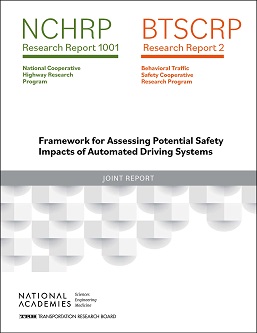 Framework for Assessing Potential Safety Impacts of Automated Driving Systems
11/8/2022 3:00:19 PM
Framework for Assessing Potential Safety Impacts of Automated Driving Systems
11/8/2022 3:00:19 PM
Quickly advancing automated driving system (ADS) technologies are expected to positively affect transportation safety. ADS includes a plethora of applications that affect safety, mobility, human factors, and environmental aspects of driving. TRB's joint publication of the National Cooperative Highway Research Program and the Behavioral Transportation Safety Cooperative Research Program is titled NCHRP Research Report 1001/BTSCRP Research Report 2: Framework for Assessing Potential Safety Impacts of...
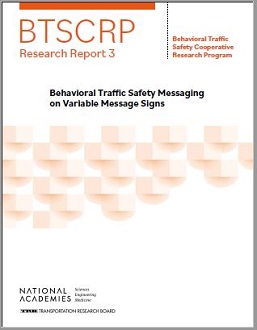 Behavioral Traffic Safety Messaging on Variable Message Signs
7/14/2022 1:00:40 PM
Behavioral Traffic Safety Messaging on Variable Message Signs
7/14/2022 1:00:40 PM
Changeable, electronic, or dynamic message signs are used to provide real-time traffic information to drivers while en route to their destination. Many agencies also use these signs to display safety messages when the signs are not being used to display other traffic information. These types of messages encourage safe driving behaviors such as wearing seat belts and not drinking and driving. The TRB Behavioral Traffic Safety Cooperative Research Program's BTSCRP Research Report 3: Behavioral Traffic Safe...
|
|